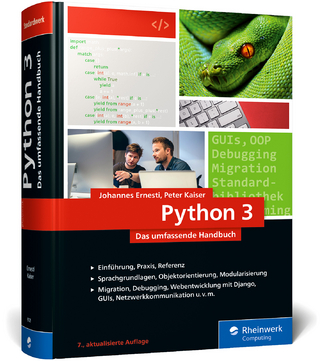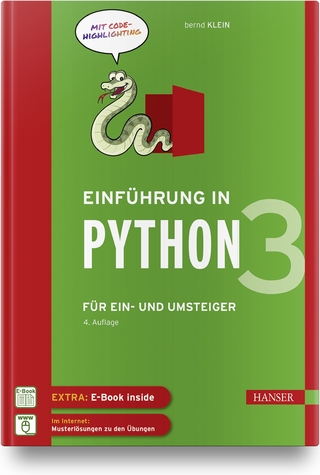
Python: Deeper Insights into Machine Learning
Packt Publishing Limited (Verlag)
978-1-78712-857-6 (ISBN)
About This Book
* Improve and optimise machine learning systems using effective strategies.
* Develop a strategy to deal with a large amount of data.
* Use of Python code for implementing a range of machine learning algorithms and techniques.
Who This Book Is For
This title is for data scientist and researchers who are already into the field of data science and want to see machine learning in action and explore its real-world application. Prior knowledge of Python programming and mathematics is must with basic knowledge of machine learning concepts.
What You Will Learn
* Learn to write clean and elegant Python code that will optimize the strength of your algorithms
* Uncover hidden patterns and structures in data with clustering
* Improve accuracy and consistency of results using powerful feature engineering techniques
* Gain practical and theoretical understanding of cutting-edge deep learning algorithms
* Solve unique tasks by building models
* Get grips on the machine learning design process
In Detail
Machine learning and predictive analytics are becoming one of the key strategies for unlocking growth in a challenging contemporary marketplace. It is one of the fastest growing trends in modern computing, and everyone wants to get into the field of machine learning. In order to obtain sufficient recognition in this field, one must be able to understand and design a machine learning system that serves the needs of a project.
The idea is to prepare a learning path that will help you to tackle the real-world complexities of modern machine learning with innovative and cutting-edge techniques. Also, it will give you a solid foundation in the machine learning design process, and enable you to build customized machine learning models to solve unique problems.
The course begins with getting your Python fundamentals nailed down. It focuses on answering the right questions that cove a wide range of powerful Python libraries, including scikit-learn Theano and Keras.After getting familiar with Python core concepts, it's time to dive into the field of data science. You will further gain a solid foundation on the machine learning design and also learn to customize models for solving problems.
At a later stage, you will get a grip on more advanced techniques and acquire a broad set of powerful skills in the area of feature selection and feature engineering.
Style and approach
This course includes all the resources that will help you jump into the data science field with Python. The aim is to walk through the elements of Python covering powerful machine learning libraries. This course will explain important machine learning models in a step-by-step manner. Each topic is well explained with real-world applications with detailed guidance.Through this comprehensive guide, you will be able to explore machine learning techniques.
Sebastian Raschka is a PhD student at Michigan State University, who develops new computational methods in the fild of computational biology. He has been ranked as the number one most inflential data scientist on GitHub by Analytics Vidhya. He has many years of experience with coding in Python and he has conducted several seminars on the practical applications of data science and machine learning. Talking and writing about data science, machine learning, and Python really motivated Sebastian to write this book in order to help people develop data-driven solutions without necessarily needing to have a machine learning background. He has also actively contributed to open source projects and methods that he implemented, which are now successfully used in machine learning competitions, such as Kaggle. In his free time, he works on models for sports predictions, and if he is not in front of the computer, he enjoys playing sports. I would like to thank my professors, Arun Ross and Pang-Ning Tan, and many others who inspired me and kindled my great interest in pattern classifiation, machine learning, and data mining. I would like to take this opportunity to thank the great Python community and developers of open source packages who helped me create the perfect environment for scientifi research and data science. A special thanks goes to the core developers of scikit-learn. As a contributor to this project, I had the pleasure to work with great people, who are not only very knowledgeable when it comes to machine learning, but are also excellent programmers. Lastly, I want to thank you all for showing an interest in this book, and I sincerely hope that I can pass on my enthusiasm to join the great Python and machine learning David Julian is currently working on a machine learning project with Urban Ecological Systems Ltd and Blue Smart Farms (http://www.bluesmartfarms.com.au) to detect and predict insect infestation in greenhouse crops. He is currently collecting a labeled training set that includes images and environmental data (temperature, humidity, soil moisture, and pH), linking this data to observations of infestation (the target variable), and using it to train neural net models. The aim is to create a model that will reduce the need for direct observation, be able to anticipate insect outbreaks, and subsequently control conditions. There is a brief outline of the project at http://davejulian.net/projects/ues. David also works as a data analyst, I.T. consultant, and trainer. I would like to thank Hogan Gleeson, James Fuller, Kali McLaughlin and Nadine Miller. This book would not have been possible without the great work of the open source machine learning community John Hearty is a consultant in digital industries with substantial expertise in data science and infrastructure engineering. Having started out in mobile gaming, he was drawn to the challenge of AAA console analytics. Keen to start putting advanced machine learning techniques into practice, he signed on with Microsoft to develop player modelling capabilities and big data infrastructure at an Xbox studio. His team made signifiant strides in engineering and data science that were replicated across Microsoft Studios. Some of the more rewarding initiatives he led included player skill modelling in asymmetrical games, and the creation of player segmentation models for individualized game experiences. Eventually John struck out on his own as a consultant offering comprehensive infrastructure and analytics solutions for international client teams seeking new insights or data-driven capabilities. His favourite current engagement involves creating predictive models and quantifying the importance of user connections for a popular social network. After years spent working with data, John is largely unable to stop asking questions. In his own time, he routinely builds ML solutions in Python to fulfi a broad set of personal interests. These include a novel variant on the StyleNet computational creativity algorithm and solutions for algo-trading and geolocation-based recommendation. He currently lives in the UK.
| Erscheinungsdatum | 27.08.2017 |
|---|---|
| Verlagsort | Birmingham |
| Sprache | englisch |
| Maße | 191 x 235 mm |
| Themenwelt | Mathematik / Informatik ► Informatik ► Datenbanken |
| Informatik ► Programmiersprachen / -werkzeuge ► Python | |
| Informatik ► Software Entwicklung ► User Interfaces (HCI) | |
| Mathematik / Informatik ► Informatik ► Theorie / Studium | |
| ISBN-10 | 1-78712-857-1 / 1787128571 |
| ISBN-13 | 978-1-78712-857-6 / 9781787128576 |
| Zustand | Neuware |
| Haben Sie eine Frage zum Produkt? |
aus dem Bereich


